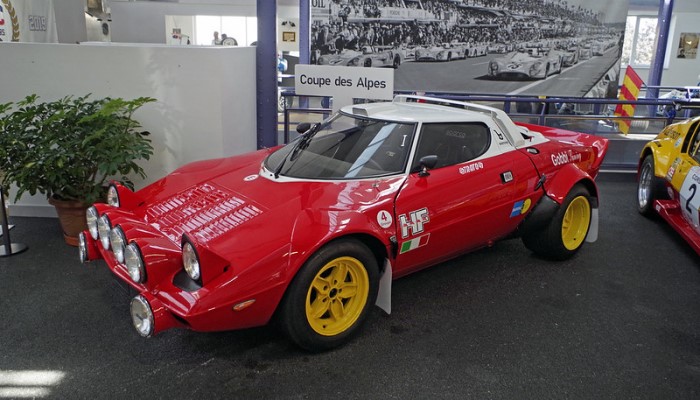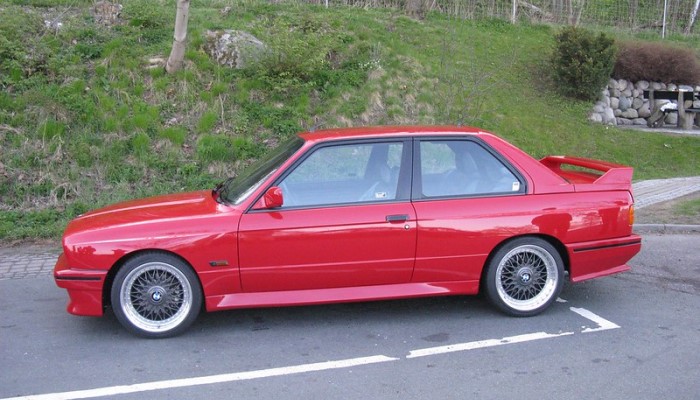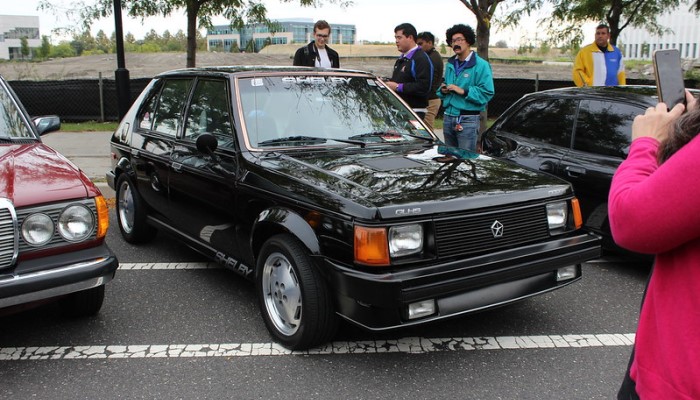Audi Quattro
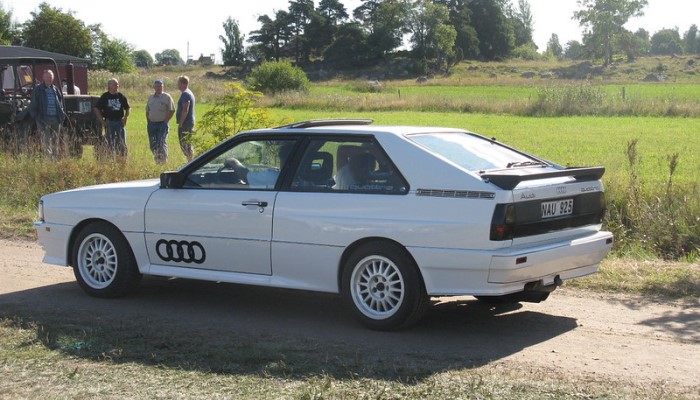
Photo: "Audi Quattro" by nakhon100
Game-Changer in the Automotive Industry
Year: 1981; Location: Monte Carlo; Event: Rally Monte Carlo.
The traditional opening of the season brought, as expected, many fantastic cars, such as the Renault 5 Turbo, Lancia Stratos HF, Fiat 131 Abarth, Ford Escort RS 1800, Porsche 911 SC, and many others.
As every year, the list of favorites was short — until that moment, Lancia and Fiat had won six of the eight driving championships, but it was expected that Ford and Renault could surprise that year. Among the competitors was the new Audi Quattro, and despite the recent victory at the lower-class rally in Austria, almost no one paid too much attention to it.
The Quattro had the latest technology that its rivals didn't: four-wheel drive, which many felt made it too heavy to make a significant mark. And then, already after the first stage, Audi driver Hannu Mikkola asked his co-driver Arne Hertz how long they were behind the fastest time. Hertz just looked at him and said that the rival's best time was ten seconds behind.
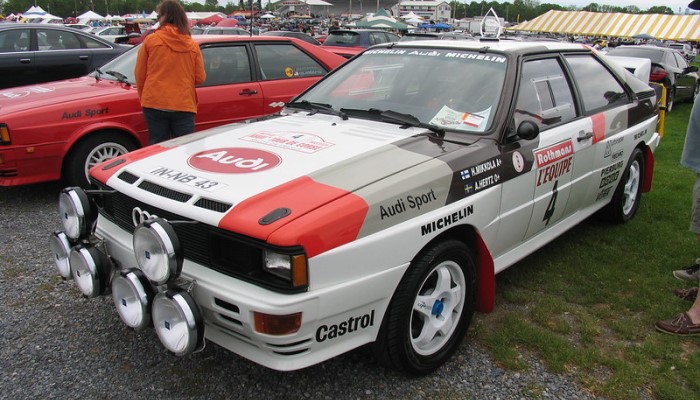
Photo: "Audi Quattro Rally Car" by Jacob Frey 4A
From that moment on, a new star was born. Over the next few years, the Quattro left a deep mark on the rally championship, as long as the standards were not banned, but that was enough time for it to acquire the status of a legend and go down in history as one of the best cars in this competition.
In order to qualify for the rally championship, Audi had to make a sufficient number of serial examples, which gave birth to another legend that will dominate the asphalt for a long time.
From Idea to Legend
The history of the Audi Quattro dates back to the mid-1970s, when one of the team's engineers, Jörg Bensinger, tested the Volkswagen Iltis in harsh winter conditions in Scandinavia. Bensinger noted that the four-wheel drive of this military vehicle manages to overcome all weather conditions without problems, from snow to mud to gravel.
Even the best off-road cars of the mentioned time did not manage to overcome off-road conditions with such ease, so the choice mostly fell on some proven SUV, such as a Land Rover or Jeep CJ.
Bensinger came up with the idea that four-wheel drive would really differentiate Audi from the competition and, in his spare time, began working on a similar system on his private Audi 80. The idea was presented to Dr. Ferdinand Piëch, the company's technical director, in 1977.
The first prototype was built on the mentioned Audi 80 and provided an in-line 5 engine with 170 hp. Although solidly built, the said Audi 80 was, without much effort, left in the mud of difficult terrain in Sweden behind the Iltis, which had only 75 hp.
Although the power proved to be high enough, the rear-wheel drive was not ideal for difficult terrain. Piëch soon gathers a team of young engineers around him, and the project receives significant attention under the "Development Order 262" designation, although many called it A1 or allrad (four-wheel drive).
The team did not have a large budget, since few in the company expected greater success, and the greatest attention was paid to the turbo engine, which was supposed to be under the hood of the new Audi 200 in the near future.
For this reason, the team had to use already existing parts from many Volkswagen and Audi models, so the suspension and gearbox were taken from the Audi 100, the shell from the Audi 80, and the in-line 5 turbo engine from the future Audi 80 Coupe.
Presentation
The first completely finished prototype was presented to the company's leaders in September 1977, and soon Volkswagen gave the green light for serial production. To convince the president of Volkswagen to approve this project, Piëch took Ernst Fiala, Volkswagen's director of new vehicles, to the mountains of Austria and let him drive first a standard Audi 80 and then a prototype four-wheel drive version.
Fiala kept the car over the weekend and then let his wife drive it. After minimal modifications, Fiala decided to approve the project.
All that was left to decide was the name. The early favorite for the name was Carat, but the marketing team had a much better idea and decided to call the new model Quattro, after the Italian word for four-wheel drive.
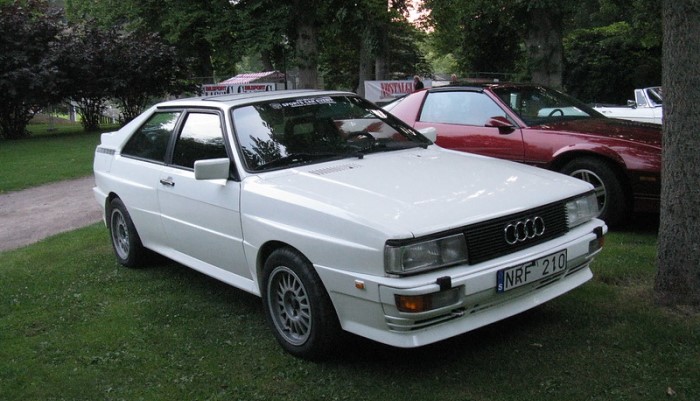
Photo: "Audi Quattro" by nakhon100
The official presentation followed at the Geneva Motor Show in March 1980, and the audience was delighted when they saw this car. In front of them stood a beautiful coupe, which was based on the new Audi 80 Coupe, also presented in the same year, with a length of 173.4 in (4,404 mm).
Although billed as one of the first four-wheel-drive cars to be produced in large numbers, the Quattro was not the first, and that honor went to the AMC Eagle. However, while this American firm provided a model of dull design and inefficient engines, the Quattro was a significantly more modern car.
Engine and Specs
Under the hood was a new 131ci (2.144cc) in-line 5 engine that, with the help of a turbo, developed 200 hp and 285 Nm of torque. With a weight of only 1.3 tons, acceleration to 100 kph (62 mph) was 7 seconds, with a maximum speed of 137 mph (220 kph).
The high starting price of 49,900 DM also marked great exclusivity, and only wealthy buyers were able to afford the Quattro. Production started at the end of 1980 in a small factory in Germany where all models were assembled by hand, and since Audi already had big plans for motor sports, it was known that a minimum of 400 copies would be produced for homologation.
Rally History
Although the Quattro has acquired cult status on asphalt during its history, its legend was born in the World Rally Championship (WRC). Back in the 1977 season, Audi tried its hand at this competition with the 80 model, which provided front-wheel drive, but failed to achieve significant success.
1981 Season
Early Quattro models competed in local competitions, and the first major test came in 1981 at Rally Austria. This rally was not scored in the WRC championship, and for it, the engine power was increased to 310 hp. Local hero Franz Wittmann easily won his first race with a lead of over 20 minutes over his nearest rival.
A few months later, the 1981 season officially opened with the Monte Carlo Rally, perhaps the biggest race of the competition, and it started in the best possible way. Hannu Mikkola beat the first six rivals in mostly snowy conditions but had to retire after a crash. However, already in the second race of the season, in Sweden, Quattro recorded its first victory with the famous Finnish driver.
In the 12 races of the mentioned season, this car won three and finished third in the constructors' overall standings, and perhaps the greatest success came at the Italian Rally, which was won by Michèle Mouton, who thus became the first woman to achieve this result.
1982 Season
At the beginning of the 1982 season, it became clear that the Quattro was on top of the world. Audi won 7 out of 12 races and won the constructors' title. Mikkola won in Finland, Sweden, Argentina, and Portugal, while Mouton added wins in Portugal, Greece, and Brazil, and only a breakdown in Ivory Coast prevented her from claiming the championship.
1983 Season
For the 1983 season, Audi got new competition and the appearance of the more powerful Lancia Stratos, but even that did not stop the success, so Mikkola brought the Quattro its first championship title.
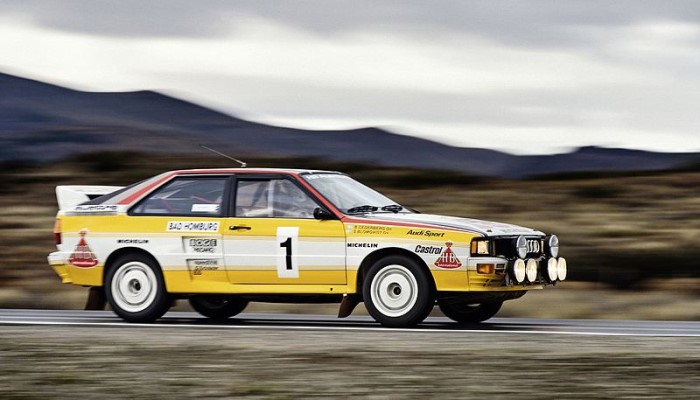
Photo: "Audi quattro A2 Group B model year 1983" by Audi Sverige.
While the production model continued to be sold in limited numbers in Europe, in 1983 sales were extended to North America, where it remained for only four years, and in that period only 664 examples found buyers.
Although the Quattro was an impressive car, its starting price seemed excessive compared to celebrated sports cars such as the Porsche 911 and Chevrolet Corvette, and when you add that the models for this market developed 160 hp due to emissions standards, it becomes clear why success was still lacking.
1984 Season
The 1984 season will go down as a turning point for the WRC. The newly formed Group B forced many teams to experiment with a centrally placed engine, and although Audi also considered this option and even built a prototype, this idea was bypassed.
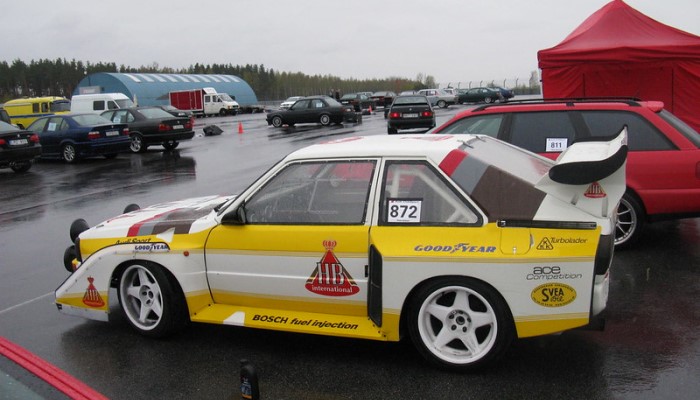
Photo: "Audi Sport Quattro" by nakhon100
The latest vehicle from Audi was the Sport Quattro, with the aim of being lighter and handling better in corners. Audi won 7 of the 12 races it ran during the 1984 season and again won the drivers and constructors titles, but at the end of the season, the first trouble came in the form of Peugeot.
Actually, Peugeot made its debut with the 205 Turbo model, which, due to its small dimensions, easily overcame all obstacles and managed to win three of the last four races.
1985 Season
For the 1985 season, Audi decided to increase the power to an impressive 476 hp, although according to some estimates, it exceeded 500 hp. Weighing just 1,090 kg (2,403 lb), the Quattro could now accelerate to 100 kph (62 mph) in 3 seconds and to 200 kph (124 mph) in 11 seconds.
Many will agree that the Audi-Peugeot rivalry during the 1985 season is perhaps the greatest in the history of this motor sport, but the number of victories still does not reflect the true happenings on the field. Because, during the 1985 season, Peugeot won seven races compared to just one for Audi and strolled to the title.
Tough Times for Motorsport
During the same period, Group B began to receive heavy criticism for being dangerous. A lot has changed at the Portugal Rally, which will play a key role in the decision to cancel Group B. Portuguese driver Joaquim Santos, at the wheel of a Ford RS200, lost control of the vehicle in a corner and crashed into the crowd watching the race.
Three people died and another 31 were injured, and after that rally, all the best teams withdrew, and the future of Group B was discussed. Not long after that, a key detail in the history of Group B takes place at the Rally Italia.
Henri Toivonen, behind the wheel of a Lancia Delta S4, led the championship, and when the rally in Corsica began, Toivonen stood out among the favorites to win. In stage 18, Toivonen crashed, and his Lancia burst into flames. Smoke could be seen at the finish, and the organizers immediately realized that something was wrong.
Half an hour later, when the rescue team appeared at the scene of the crash, they found only a burnt-out car and the charred bodies of the Finnish driver and his passenger, Sergio Cresto.
There were no witnesses, so it is only possible to guess what happened on this day. Some say that Toivenen was sick; others say that the cause of the crash was a mechanical problem; and there are also those who claim that it was the driver's fault, since Toivonen had strange crashes throughout his career when he had a high lead.
At Rallye Italia, Toivonen had a big lead, and it was hard to expect anyone to achieve a better time. This crash came a year after Attilio Bettega, at the wheel of a Lancia 037, was also killed in this same rally. The difficult terrain was considered to be his death as well as the accident, as his co-driver, Maurizio Perissinot, escaped unhurt.
After the Corsica rally, Audi automatically withdrew from Group B, and after another crash by F1 driver Marc Surer in a Ford RS200, in which his co-driver was killed, the FIA automatically suspended Group B. Although Audi continued to compete in the rally, success was limited, with the exception of 1987, when Hannu Mikkola won the Kenya Rally.
Audi Quattro on American Soil
The German team also turned to other models, such as the Audi 90 and 200, but that was not the end of the legendary Quattro. Mountain races in the American state of Colorado, called Pikes Peak, began to gain great popularity.
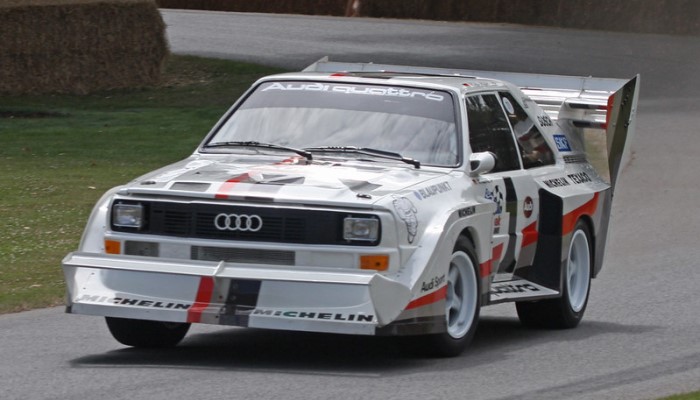
Photo: "1987 Audi Sport Quattro S1 'Pikes Peak'" by exfordy
The specially equipped Quattro with as much as 600 kg made its debut during the 1987 season with the legendary Walter Röhrl, who not only won the race but also held the track record for a long time. Victories were later achieved with two more drivers (Michèle Mouton and Bobby Unser), and to this day, the Quattro is considered one of the legends of this competition.
The success on American soil was later continued in the Trans Am series, where Audi won 8 out of 13 races and won the constructors' title in the 1988 season, and these models developed as much as 720 hp.
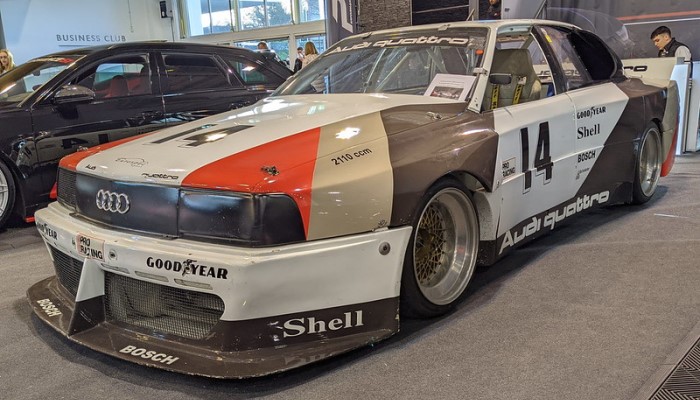
Photo: "Audi 200 quattro Trans-Am" by Triple-green
Success later continued in the DTM (German Touring Car Series), where the Quattro won the championship in the 1990 season and won half the races driven in the 1990 and 1991 seasons before the all-new Audi A4 Quattro Super Tourer debuted.
In any case, after great public interest during the early years of production, the demand for the civilian Quattro dropped sharply in the mid-1980s, and many see the Audi as the culprit.
In that period, four-wheel drive debuted on five more models of the company, which were significantly cheaper, and the end of the original Quattro came in 1991, when it was replaced by the S2 model. During 11 years of production, Audi produced a total of 11,452 Quattros, mostly without major changes, which still gives this car great exclusivity today.
Quattro in Today's Market
Looking to impress your friends and make your neighbors jealous? Look no further than the Audi Quattro! This baby is the perfect combination of engineering and performance. And yes, it still has that oh-so-coveted four-wheel drive system that made it a legend.
But wait, you're probably wondering about the price. Let me break it down for you. The Audi Quattro's price range today is... *drumroll please*... somewhere between "ouch, that's a lot" and "well, there goes my retirement fund." But hey, who needs savings when you can have a sleek, powerful machine like the Audi Quattro, am I right?
But let's get serious. The price of a basic (civilian) model ranges between $20,000 and $150,000, while for a racing car you need to "extract" up to, perhaps even, $2M! (Wow!) Here are some charts to help you out.
So go ahead, treat yourself to some German engineering excellence. Just be prepared to do some creative budgeting. Who needs a vacation anyway when you have a Quattro parked in your driveway, right?

Unique Car Zone Team
A group of several fans of everything that moves on four wheels, a few article creators, a couple of marketing strategists, designers, web developers, and lots of coffee.




